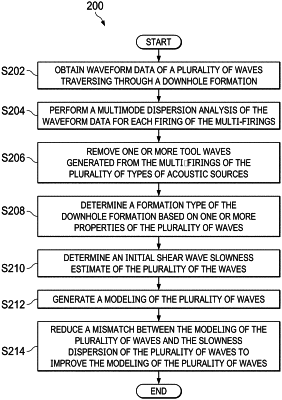| CPC G01V 1/303 (2013.01) [G01V 1/005 (2013.01); G01V 1/282 (2013.01); G01V 1/345 (2013.01)] | 20 Claims |

|
1. A method to estimate formation shear wave slowness from a plurality of types of acoustic sources, the method comprising:
obtaining waveform data of a plurality of waves traversing through a downhole formation, wherein the plurality of waves are generated from multi-firings of a plurality of types of acoustic sources;
performing a multimode dispersion analysis of the waveform data for each firing of the multi-firings;
removing one or more tool waves generated from the multi-firings of the plurality of types of acoustic sources;
determining a formation type of the downhole formation based on one or more properties of the plurality of waves;
determining an initial shear wave slowness estimate of the plurality of the waves;
generating a modeling of the plurality of waves; and
reducing a mismatch between the modeling of the plurality of waves and a slowness dispersion of the plurality of waves to improve the modeling of the plurality of waves,
wherein determining the type of the downhole formation comprises determining the formation type based on an existence of a first refracted shear or a first weak-dispersive high order mode in a first wave of the plurality of waves that is generated from a first acoustic source of the plurality of acoustic sources, or a second refracted shear or a second weak-dispersive high order mode in a second wave of the plurality of waves that is generated from a second acoustic source of the plurality of acoustic sources that is different from the first acoustic source.
|